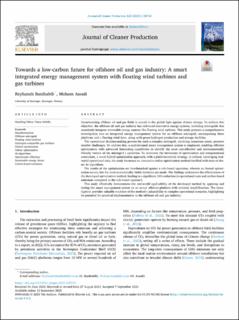| dc.contributor.author | Banihabib, Reyhaneh | |
| dc.contributor.author | Assadi, Mohsen | |
| dc.date.accessioned | 2023-11-15T10:17:10Z | |
| dc.date.available | 2023-11-15T10:17:10Z | |
| dc.date.created | 2023-09-18T19:17:41Z | |
| dc.date.issued | 2023 | |
| dc.identifier.citation | Banihabib, R., & Assadi, M. (2023). Towards a low-carbon future for offshore oil and gas industry: A smart integrated energy management system with floating wind turbines and gas turbines. Journal of Cleaner Production, 423, 138742. | en_US |
| dc.identifier.issn | 0959-6526 | |
| dc.identifier.uri | https://hdl.handle.net/11250/3102682 | |
| dc.description.abstract | Decarbonizing offshore oil and gas fields is crucial in the global fight against climate change. To achieve this objective, the offshore oil and gas industry has embraced innovative energy systems, including microgrids that seamlessly integrate renewable energy sources like floating wind turbines. This study presents a comprehensive investigation into an integrated energy management system for an offshore microgrid, encompassing three platforms and a floating wind farm, along with green hydrogen production and storage facilities.
The operational decision-making process for such a complex microgrid, involving numerous assets, presents notable challenges. To address this, a sophisticated smart management system is employed, enabling efficient optimization with advanced forecasting capabilities to identify the most cost-effective and environmentally friendly version of the microgrid's operation. To overcome the intricacies of optimization and computational constraints, a novel hybrid optimization approach, with a platform-centric strategy, is utilized. Leveraging real-world operational data, the study harnesses an innovative online optimization method fortified with state-of-the-art AI algorithms.
The results of the optimization are benchmarked against a rule-based operation, wherein no formal optimization occurs, but the most economically viable decisions are made. The findings underscore the effectiveness of the developed optimization method, leading to a significant 16% reduction in operational costs and carbon-based emissions compared to the rule-based approach.
This study effectively demonstrates the real-world applicability of the developed method by applying and testing the smart management system on an actual offshore platform with minimal simplifications. The investigation provides valuable evidence of the method's adaptability to complex operational scenarios, highlighting its potential for practical implementation in the offshore oil and gas industry. | en_US |
| dc.language.iso | eng | en_US |
| dc.publisher | Elsevier | en_US |
| dc.rights | Navngivelse 4.0 Internasjonal | * |
| dc.rights.uri | http://creativecommons.org/licenses/by/4.0/deed.no | * |
| dc.title | Towards a Low-Carbon Future for Offshore Oil and Gas Industry A Smart Integrated Energy Management System with Floating Wind Turbines and Gas Turbines | en_US |
| dc.title.alternative | Towards a Low-Carbon Future for Offshore Oil and Gas Industry A Smart Integrated Energy Management System with Floating Wind Turbines and Gas Turbines | en_US |
| dc.type | Peer reviewed | en_US |
| dc.type | Journal article | en_US |
| dc.description.version | publishedVersion | en_US |
| dc.rights.holder | © The Author(s) 2023 | en_US |
| dc.subject.nsi | VDP::Matematikk og Naturvitenskap: 400 | en_US |
| dc.source.volume | 423 | en_US |
| dc.source.journal | Journal of Cleaner Production | en_US |
| dc.identifier.doi | 10.1016/j.jclepro.2023.138742 | |
| dc.identifier.cristin | 2176233 | |
| cristin.ispublished | true | |
| cristin.fulltext | original | |
| cristin.qualitycode | 2 | |

